Abstract
In modern economic conditions, each company seeks to increase the level of competitiveness. In this regard, it is necessary to use modern management tools, including those based on information technology. For effective company management, it is necessary to timely examine its business processes. Effective management measures are selected depending on the completeness of the description and modeling of business processes. This article provides a description of business processes, describes the possible strategy and SWOT analysis on the example of car service activities. It is shown that to analyze the current activities of the company, they use the «goal tree», «problem tree», «strategy tree». The proposed company strategy is aimed at increasing the company's profits. SWOT analysis and analysis of the external environment of the company revealed the strengths and weaknesses to improve future activities. Based on a comprehensive analysis business process models in the «as is» and «to be» notations will be developed that will allow company management to assess the state of the companies business processes before and after their improvement. Such a research is aimed at choosing a strategy for improving or reengineering the company activities.
Keywords: Business processbusiness process mapgoal treeproblem treestrategy treeSWOT analysisinformation technologyMsVisio
Introduction
Analysis of the organization’s activities is carried out in connection with the need to assess the effectiveness of its activities, including with the aim of improving management efficiency and improving business processes (Kintonova et al., 2019). Currently, most companies use modern information, network, mobile and cloud technologies to automate various business processes. However, in the era of the development of the digital economy, there is a need for constant monitoring and evaluation of the effectiveness of the company for various indicators (Mitrofanova & Kopysheva, 2015). In addition, there is an improvement in the business processes and activities of companies as a whole, including expansion, modernization, and reengineering. In this regard, there is a need for a comprehensive analysis of activities company and a description of business processes «as is», as well as the development of the concept of «to be». The aim of this work is to study the features of the analysis of the company and its business processes on the example of a car service. The relevance of the work is due to the need to develop an algorithm for the required analysis. To visualize the analysis of the activities and business processes of the car service, the tools of the MsVisio application program were used.
To conduct a comprehensive analysis that reflects the real situation, it is necessary to highlight the goal, mission and strategy of the company.
The goal of the company is considered to be some expected result or the expected state of any object (company, performance indicators, areas of activity, etc.). The most effective method in task planning is the goal tree method. The goal tree is a set of company goals, structured by level (hierarchy, rank) (Balocco et al., 2019). That is, it is a visualization of the achievement of the main goal due to the combination of additional and secondary goals. An image of the company's plans in the form of a scheme allows the company's management to identify probable problems in the future to achieve the main goal.
Methods
For a comprehensive analysis of the companies activities, used the «goal tree» of the object (the «wish tree»); «Tree of problems» of the object; «Tree of goals» of the subject; «Tree of strategies» («decision tree»).
First of all, a «goal tree» of the object is built, which reflects the basic wishes for the existence and development of the object under study. Then they are decomposed in the most detail from the position of satisfying the main goals. The next step is to analyze the problems in satisfying the desires and needs of the investigated object. A «tree of problems» is being built, decomposable key problems. Then a «goal tree» is compiled from the point of view of the subject, reflecting the position of the «tree of problems». In conclusion, the «goal tree» is supplemented by strategies (options) for solving the problems posed, i.e. formed a «tree of strategies» (Balocco et al., 2019; Strang, 2019; Volik, 2017). Figure
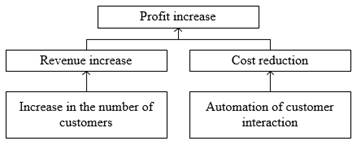
Figure

Figure
1) Additional training and professional development of employees will significantly improve the quality of services provided.
2) In parallel, it is recommended to work on improving the marketing component, which will increase the number of customers, and therefore increase revenues and profits.
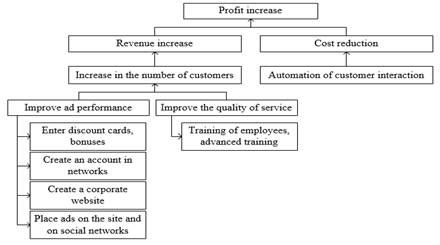
Results and discussion
Based on the analysis of the activities of the studied company, the strategies (means of achieving goals) presented in Figure
The advantages of implementing the proposed strategies are: improving the quality of information processing and storage, increasing competitiveness, and a significant reduction in costs. However, there are also disadvantages: advertising costs, staff training costs and automation.
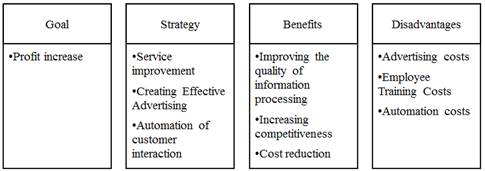
The study of the effectiveness of the company should be carried out on the basis of the SWOT analysis presented in table
The greatest impact on the effectiveness of the company has the external environment - a set of factors (conditions and organizations) that affect the activities of the company (Arbatani et al., 2019; Kovaleva et al., 2015). The external environment of a car service is shown in Figure
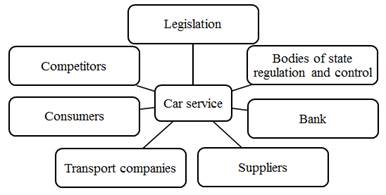
An important stage in the analysis of the company is the formation of a map of business processes. The business process in the company’s activities is an interconnected set of works, a structured set of actions that is carried out according to specified requirements and ensures the achievement of the desired end result. Creating a business process map is one of the most effective approaches to optimizing business processes (Munsamy et al., 2019; Satyal et al., 2019). A map of the business processes of a car service is shown in Figure
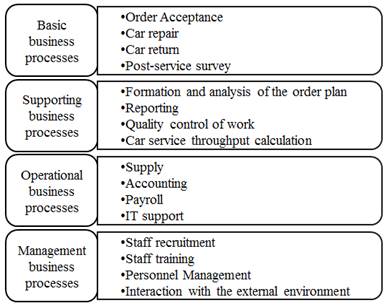
The map of business processes will visually reflect all the business processes of the company, which greatly facilitates their analysis in order to improve. A carefully designed business process map of the company is able to indicate its strengths and weaknesses, as well as contribute to making an actual decision on the level of improvement of the company's business processes. In the car service under study, there is a need to improve the business process of interacting with customers by introducing an information system that will allow you to build a strategy for interacting with customers based on the following components: improving the level of services provided and customer satisfaction, marketing optimization, customer focus, improving business processes, the ability to analyze key performance indicators of the company.
Thus, as a result of the study, it was found that in order to conduct an effective analysis of the company’s activities and develop relevant reengineering recommendations, the company’s management and/or business process specialists need to develop a «goal tree», «problem tree», «strategy tree», SWOT analysis and map of business processes. All prepared documents will allow to visually present the existing tasks and ways to solve them. In addition, the information provided can be used as a basis for describing a company's business processes using «as is» and «to be» notations during the development of a business processes improvement project.
References
- Arbatani, T., Norouzi, E., Omidi, A., & Valero-Pastor, J. (2019). Competitive strategies of mobile applications in online taxi services: The cases of Snapp and Tap30 in Iran. International Journal of Emerging Markets.
- Balocco, R., Cavallo, A., Ghezzi, A., & Berbegal-Mirabent, J. (2019). Lean business models change process in digital entrepreneurship. Business Process Management Journal, 25(7), 1520-1542.
- Kintonova, A. Z., Yermaganbetova, M. A., Abildinovaa, G. M., Abdugulova, Z. K., Glazyrina, N. S., & Ospanova, N. N. (2019). Optimization of business processes based on the supply chain management in an accounting department. International Journal of Supply Chain Management, 8(3), 369-379.
- Kovaleva, M. A., Korovkina, A. Yu., Voloshin, S. B., Syrtsev, G. A., & Farniev, S. R. (2015). The system of automated monitoring and forecasting in the management of educational systems. Proceedings of young scientists of the Vladikavkaz Scientific Center of the Russian Academy of Sciences, 15(1), 21-30.
- Mitrofanova, T. V., & Kopysheva, T. N. (2015). On a technology for designing 3d objects for geographic information systems. Information and telecommunication systems and technologies All-Russian scientific and practical conference, 208.
- Munsamy, M., Telukdarie, A., & Fresner, J. (2019). Business process centric energy modelling. Business Process Management Journal, 25(7), 1867-1890.
- Satyal, S., Weber, I., Paik, H.-Y., Di Ciccio, C., & Mendling, J. (2019). Business process improvement with the AB-BPM methodology. Information Systems, 84, 283-298.
- Strang, K. D. (2019). Analysing non-profit business processes using a soft systems methodology. International Journal of Business Performance Management, 20(2), 177-194.
- Volik, M. V. (2017). Features of enterprise management automation through the implementation of information systems. Economics and Entrepreneurship, 9-2 (86), 733-736.
- Volik, M. V. (2018). Digital economy and information technology in company management. Humanitarian and socio-economic sciences, 6(103), 173-175.
Copyright information

This work is licensed under a Creative Commons Attribution-NonCommercial-NoDerivatives 4.0 International License.
About this article
Publication Date
08 March 2021
Article Doi
eBook ISBN
978-1-80296-102-7
Publisher
European Publisher
Volume
103
Print ISBN (optional)
-
Edition Number
1st Edition
Pages
1-644
Subjects
Digital economy, cybersecurity, entrepreneurship, business models, organizational behavior, entrepreneurial behavior, behavioral finance, personnel competencies
Cite this article as:
Volik, M., Kovaleva, M., Kopysheva, T., & Mitrofanova, T. (2021). Methodology For Analyzing The Company's Business Processes (For Example, Car Service). In N. Lomakin (Ed.), Finance, Entrepreneurship and Technologies in Digital Economy, vol 103. European Proceedings of Social and Behavioural Sciences (pp. 421-426). European Publisher. https://doi.org/10.15405/epsbs.2021.03.52

